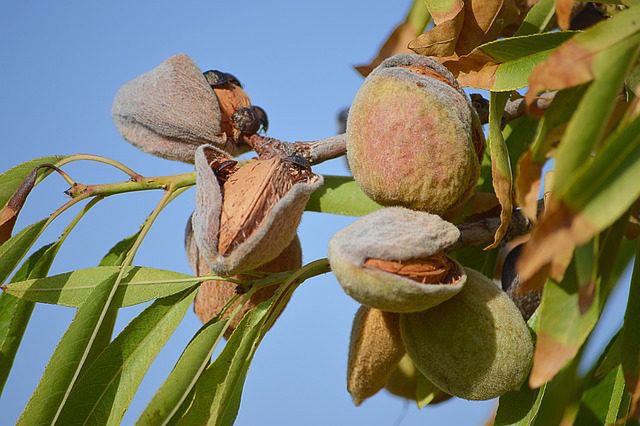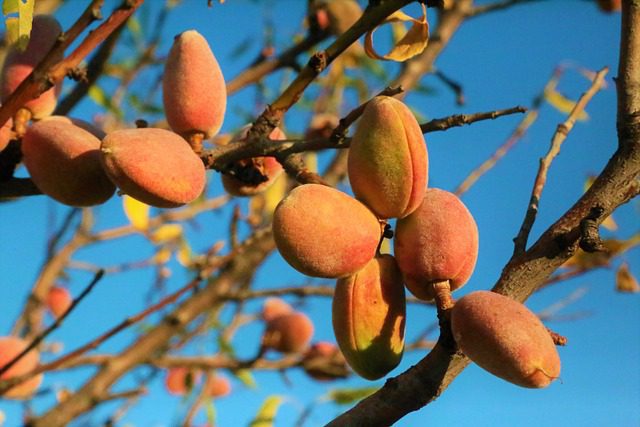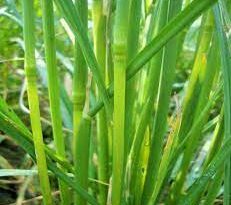How To Grow Almond and Its Benefits
How to grow almond will be covered in this post, but first, what is almond? Almonds (Prunus dulcis) are a fascinating and valuable crop in the world of agriculture, renowned for their distinctive characteristics and significant economic importance. Almond trees belong to the Rosaceae family, making them relatives of other fruit-bearing trees like peaches, plums, and cherries. They are deciduous trees, which means they shed their leaves seasonally. Almond trees typically reach a height of 13 to 33 feet (4 to 10 meters) and exhibit a somewhat spreading growth habit.
The leaves of almond trees are elongated and serrated at the edges. They are lanceolate in shape, with a deep green color, and are arranged alternately along the branches. These leaves play a vital role in the photosynthesis process, contributing to the tree’s overall health and nut production. Almond trees produce exquisite, fragrant flowers that are a sight to behold in late winter or early spring, depending on the climate. These flowers are characterized by five petals and a distinctive pink or white coloration.
Almond blossoms are often among the first signs of spring, making them a crucial component of early pollinator habitats. The fruit of almond trees is technically a drupe, consisting of an outer hull, a hard shell, and the edible almond seed within. Almonds themselves are seeds, not true nuts, and they have a unique kidney-like shape. When mature, the hull splits open, revealing the hard shell that protects the almond kernel.
There are various almond varieties cultivated globally, each with its own unique characteristics, including size, flavor, and shell hardness. Prominent almond varieties include Nonpareil, Carmel, Sonora, and Butte. Nonpareil, known for its smooth, thin shell and excellent kernel quality, is one of the most widely grown and recognized almond varieties.
How to Grow Almond
Growing almonds can be a rewarding endeavor, but it requires careful attention to various factors to ensure a successful crop. Here, I’ll provide you with a comprehensive guide on how to grow almonds in an agricultural setting:
1. Selecting the Right Location: Almonds thrive in regions with a Mediterranean climate, characterized by mild, wet winters and hot, dry summers. They require a minimum of 300 to 400 chill hours (hours below 45°F or 7°C) during the winter for proper bud development. It prefers well-drained soils with a pH level between 6.0 and 7.5. Ensure that the soil is deep and free from compaction to allow for healthy root development.
2. Choosing Almond Varieties: Select almond varieties that are well-suited to your climate and intended use. Popular almond cultivars include Nonpareil, Carmel, and Butte, each with its own unique characteristics, such as kernel quality and shell hardness.
3. Planting Almond Trees: Almond trees are typically planted during the dormant season, which is in late winter or early spring before the buds break. This allows the tree to establish roots before the growing season. Plant almond trees with sufficient spacing to accommodate their mature size.
Standard spacing is often around 18 to 22 feet (5.5 to 6.7 meters) between trees in rows and 20 to 24 feet (6.1 to 7.3 meters) between rows. Ensure that the tree is planted at the same depth as it was in the nursery. Avoid burying the graft union, which should remain above the soil line.
4. Irrigation: Almond trees benefit from efficient drip irrigation systems that deliver water directly to the root zone. Proper moisture management is crucial, especially during the growing season.
Young almond trees require more frequent watering, gradually transitioning to deeper, less frequent irrigation as they mature. Adequate moisture during the nut filling and hull split stages is critical for nut development.
5. Fertilization: Conduct soil tests to determine nutrient deficiencies and tailor your fertilization program accordingly. Nitrogen, phosphorus, potassium, and micronutrients are essential for almond tree health and productivity.
6. Pruning and Training: Regular pruning and training are essential to shaping the tree, promoting air circulation, and facilitating sunlight penetration. This helps prevent disease and ensure even nut development. Pruning is typically done during the dormant season.
7. Pest and Disease Management: Implement integrated pest management (IPM) strategies to monitor and control pests and diseases. Common almond pests include aphids, mites, and navel orangeworm, while diseases like brown rot and shot hole can affect almond trees.
8. Harvesting: Almonds are ready for harvest when the hulls split open, revealing the mature nuts inside. Mechanical shakers are often used to shake the almonds from the tree, after which they are collected and processed. Harvesting usually occurs in late summer or early autumn.
9. Post-Harvest Handling: Proper post-harvest handling is crucial to maintaining almond quality. After harvesting, almonds are dried to a moisture content of about 6%, hulled to remove the outer shell, and then sorted and packaged for sale or processing.
Read Also: Complete Guide on How to Grow Blackberries
What are the Benefits of Almond?
Almonds are renowned for their numerous health benefits and versatile culinary uses. I do like to highlight the many advantages of incorporating almonds into both a balanced diet and agricultural practices:
1. Nutrient-Rich Profile: Almonds are a powerhouse of essential nutrients, including healthy fats, protein, dietary fiber, vitamins (particularly vitamin E), and minerals such as magnesium and calcium.
2. Heart Health: Regular consumption of almonds is associated with improved heart health. Their unsaturated fats, specifically monounsaturated fats, can help reduce LDL cholesterol levels, lowering the risk of heart disease.
3. Weight Management: Despite being calorie-dense, almonds are a satisfying and nutritious snack. Their combination of protein, fiber, and healthy fats can promote feelings of fullness, potentially aiding in weight management when consumed in moderation.
4. Blood Sugar Control: Almonds have a low glycemic index, which means they have a minimal impact on blood sugar levels. This can be particularly beneficial for individuals with diabetes or those at risk of developing the condition.
5. Antioxidant Properties: Almonds are rich in antioxidants, including vitamin E and polyphenols. These compounds help combat oxidative stress and reduce the risk of chronic diseases.
6. Bone Health: The calcium content in almonds supports healthy bones and teeth. Additionally, the magnesium in almonds aids in calcium absorption and bone mineralization.
7. Skin Health: Vitamin E in almonds is known for its role in maintaining healthy skin. It helps protect the skin cells from damage caused by UV rays and oxidative stress.
8. Digestive Health: Almonds are a good source of dietary fiber, promoting digestive regularity and gut health. They can aid in preventing constipation and maintaining a healthy gut microbiome.
9. Cognitive Function: Some studies suggest that the nutrients in almonds, particularly vitamin E and healthy fats, may support cognitive function and reduce the risk of age-related cognitive decline.
10. Sustainable Crop: From an agricultural perspective, almonds are a sustainable crop. They require less water compared to some other tree crops and can be grown in regions with suitable climates, contributing positively to local economies.
11. Economic Benefits: Cultivating almonds can be economically rewarding for agricultural communities. Almonds are a valuable crop with strong global market demand, providing income opportunities for growers and supporting rural economies.
12. Culinary Versatility: Almonds are a versatile ingredient in various culinary applications. They can be used in salads, baked goods, smoothies, and as almond butter or almond milk, offering both flavor and nutritional benefits.
How to Harvest Almond

Harvesting almonds is a crucial step in the cultivation process that requires careful timing and proper techniques to ensure the highest quality nuts. As an expert in agriculture, I’ll provide you with a detailed guide on how to harvest almonds:
1. Timing of Harvest: Almonds are typically ready for harvest when the hulls, the outer fleshy covering of the nut, begin to split open naturally. This is a key indicator that the nuts inside have matured.
Regularly monitor the development of the nuts in the weeks leading up to the expected harvest time. Almonds usually mature between late summer and early autumn, depending on the climate and almond variety.
2. Equipment and Tools: Mechanical shakers are commonly used in commercial almond orchards. These machines gently shake the tree trunk and branches to dislodge the ripe nuts.
Place harvesting tarps or nets beneath the almond trees to catch the falling nuts. These tarps make it easier to collect the almonds efficiently and reduce potential damage to the nuts.
3. Harvesting Process: Use mechanical shakers to shake the almond trees. This should be done with care to avoid damaging the trees or causing excessive stress. The shaking action dislodges the almonds from the branches and allows them to fall onto the tarps or nets. After shaking, carefully gather the almonds from the tarps or nets. Ensure that no nuts remain on the ground, as they can attract pests and reduce the overall yield.
Almonds may still have some remaining hull material attached to them. To remove this, almonds are typically cleaned and sorted using equipment like air blowers, screens, and conveyors.
Depending on the moisture content of the almonds and local weather conditions, almonds may need to be dried to achieve the ideal moisture level of around 6%. This can be done using drying equipment or by laying them out in a well-ventilated area.
4. Post-Harvest Handling: Once almonds are dried and cleaned, the outer hulls are mechanically removed, revealing the inner shell and kernel. Store the hulled almonds in a cool, dry place with good ventilation to prevent moisture buildup and spoilage. Proper storage is essential for maintaining almond quality. Almonds can be processed further for various end products, such as almond butter, almond flour, or almond milk.
5. Safety Considerations: When operating mechanical shakers or working around almond trees during harvest, it’s crucial to use appropriate safety gear, including helmets, gloves, and eye protection. Regularly maintain and inspect harvesting equipment to ensure safe and efficient operation.
Read Also: How To Grow Apricot Trees
How to Store Almond
Storing almonds properly is essential to maintaining their freshness, flavor, and nutritional value over an extended period. As an expert in agriculture, I’ll provide you with a comprehensive guide on how to store almonds effectively:
1. Select High-Quality Almonds: Start with high-quality almonds. Check for freshness, ensuring they have a pleasant aroma and a crisp texture. Avoid almonds with off-putting odors or signs of mold or moisture.
2. Choose the Right Container: Opt for airtight containers or resealable bags to prevent exposure to air and moisture. Glass or plastic containers with tight-fitting lids are suitable options. Ensure that the container is clean and dry before storing almonds.
3. Store in a Cool Location: Almonds are sensitive to temperature fluctuations. Store them in a cool, dark place, away from direct sunlight and heat sources. Ideally, the storage temperature should be between 32°F (0°C) and 45°F (7°C).
4. Maintain Low Humidity: Almonds are prone to absorbing moisture, which can lead to spoilage or the growth of mold. Ensure that the storage environment has low humidity levels to prevent moisture absorption.
5. Vacuum Sealing (Optional): For long-term storage, consider vacuum-sealing almonds. Vacuum-sealed bags remove excess air and create an airtight seal, further extending the shelf life of the almonds.
6. Use the Freezer for Extended Storage: If you plan to store almonds for an extended period, you can use the freezer. Place the almonds in an airtight, moisture-proof container or vacuum-sealed bag. Frozen almonds can remain fresh for up to a year or more.
7. Avoid Mixing with Strongly Aromatic foods: Almonds can absorb odors from their surroundings. Store them separately from strongly aromatic foods like spices or onions to prevent flavor contamination.
8. Regularly Check for Freshness: Periodically inspect stored almonds for any signs of spoilage, such as off-odors, discoloration, or a rancid taste. If any almonds show these signs, remove them to prevent the spoilage from spreading to the rest of the batch.
9. Label and Date Containers: Labeling and dating the containers can help you keep track of the freshness of your almonds. This is especially important if you have multiple containers with different storage dates.
10. Roasted vs. Raw Almonds: Roasted almonds have a shorter shelf life than raw almonds due to the cooking process. Keep this in mind when considering the storage duration.
11. Use Oxygen Absorbers (Optional): In environments with fluctuating humidity levels, you can include food-safe oxygen absorbers in the storage containers to help maintain a low-oxygen atmosphere, further prolonging almond freshness.
What are the Pests and Diseases of Almond?
Identifying and managing pests and diseases in almond cultivation is critical for maintaining healthy trees and ensuring a successful harvest. Here, I’ll provide you with an overview of common pests and diseases that affect almonds, along with strategies for effective agricultural management:
Common Pests:
1. Navel Orangeworm (Amyelois transitella): This is one of the most destructive pests for almonds. Navel orangeworm larvae infest almond kernels, leading to reduced quality and yield. Monitoring and timely insecticide applications during the growing season are essential for control.
2. Aphids (Various Species): Aphids feed on almond leaves and can transmit plant viruses. They can weaken trees and reduce nut production. Natural predators like ladybugs and parasitic wasps can help control aphid populations.
3. Spider Mites (Tetranychus urticae): Spider mites can damage almond leaves by feeding on plant juices. Regular monitoring and the use of beneficial predators like predatory mites can help manage spider mite infestations.
4. Scale Insects (Various Species): Scale insects can harm almond trees by feeding on sap and weakening the plant. Applying horticultural oil or introducing natural predators can help control scale infestations.
Common Diseases:
1. Brown Rot (Monilinia spp.): Brown rot is a fungal disease that affects almond blossoms and fruit. It can lead to fruit rot and reduce crop quality. Fungicides and proper sanitation practices, including removing and destroying infected fruit, are key control methods.
2. Shot Hole Disease (Wilsonomyces carpophilus): Shot hole disease causes small, round lesions on almond leaves, which eventually fall out, leaving a shot-hole appearance. Fungicides and proper sanitation can help manage this disease.
3. Leaf Curl (Taphrina deformans): Leaf curl is a common disease affecting almond trees. It causes curling, distortion, and reddening of leaves. Preventive measures, such as applying fungicides during the dormant season, can help control this disease.
4. Canker Diseases (Various Species): Canker diseases, such as bacterial canker (Pseudomonas spp.) and fungal canker (Leucostoma spp.), can cause dieback of branches and damage to the trunk. Pruning infected branches and maintaining tree health are important management practices.
Integrated Pest and Disease Management (IPM) Strategies:
- Monitoring: Regularly inspect almond orchards for signs of pests and diseases. Early detection allows for timely intervention.
- Cultural Practices: Implement proper irrigation, fertilization, and pruning practices to maintain tree health and reduce stress, making trees less susceptible to pests and diseases.
- Biological Control: Encourage natural predators and beneficial insects that prey on pests. For example, ladybugs, parasitoid wasps, and predatory mites can help control aphids and mites.
- Chemical Control: When necessary, use pesticides judiciously and in accordance with recommended guidelines. Rotate chemical classes to prevent pest resistance.
- Sanitation: Remove and destroy diseased plant material, fallen fruit, and pruned branches to reduce disease spread.
- Resistant Varieties: Consider planting almond varieties that are resistant to specific diseases if they are prevalent in your region.
- Crop Rotation: If possible, practice crop rotation to disrupt pest and disease cycles.
Read Also: 17 Medicinal Health Benefits of Matud’s Prickly Pear (Opuntia matudae)









